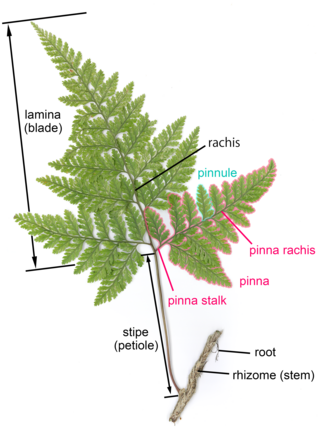
A frond is a large, divided leaf. In both common usage and botanical nomenclature, the leaves of ferns are referred to as fronds and some botanists restrict the term to this group. Other botanists allow the term frond to also apply to the large leaves of cycads, as well as palms (Arecaceae) and various other flowering plants, such as mimosa or sumac. "Frond" is commonly used to identify a large, compound leaf, but if the term is used botanically to refer to the leaves of ferns and algae it may be applied to smaller and undivided leaves.

Asplenium platyneuron, commonly known as ebony spleenwort or brownstem spleenwort, is a fern native to North America east of the Rocky Mountains. It takes its common name from its dark, reddish-brown, glossy stipe and rachis, which support a once-divided, pinnate leaf. The fertile fronds, which die off in the winter, are darker green and stand upright, while the sterile fronds are evergreen and lie flat on the ground. An auricle at the base of each pinna points towards the tip of the frond. The dimorphic fronds and alternate, rather than opposite, pinnae distinguish it from the similar black-stemmed spleenwort.

Adiantum aleuticum, the western maidenhair fern or Aleutian maidenhair, is a species of deciduous fern in the genus Adiantum.
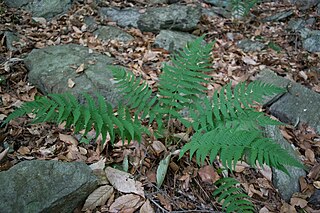
Dryopteris marginalis, vernacularly known as the marginal shield fern or marginal wood fern, is a perennial species of fern found in damp shady areas throughout eastern North America, from Texas to Minnesota and Newfoundland. It favors moderately acid to circumneutral soils in cooler areas but is fairly drought-resistant once established. In the warmer parts of its range, it is most likely to be found on north-facing non-calcareous rock faces. It is common in many altitudes throughout its range, from high ledges to rocky slopes and stream banks. Marginal wood fern's name derives from the fact that the sori are located on the margins, or edges of the leaflets.

Aspidotis is a small genus of leptosporangiate ferns known commonly as laceferns. Most species are native to slopes, ridges, and rocky outcroppings, primarily in California and Mexico, although one species included in the genus by some authorities is widely distributed in eastern Africa.
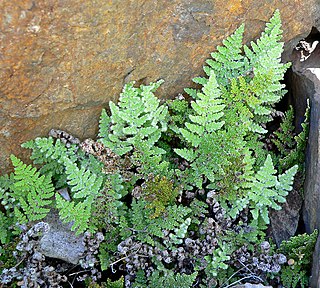
Myriopteris covillei, formerly known as Cheilanthes covillei, is a species of cheilanthoid fern known by the common name Coville's lip fern. Coville's lip fern is native to the southwestern United States and Mexico.
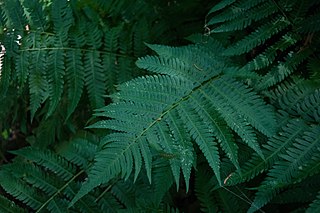
Dryopteris goldieana, commonly called Goldie's wood fern, or giant wood fern is a fern native to the eastern United States and adjacent areas of Canada, from New Brunswick to Ontario and Georgia. It is the largest native North American species of Dryopteris and along with ostrich fern it is one of the largest ferns in eastern North America. Specimens are known with fronds six feet tall. D. goldieana hybridizes with many other species of Dryopteris and the hybrids tend to be larger than the pure species. It was named by William Hooker in honor of its discoverer, John Goldie. The epithet was originally published as goldiana, but this is regarded as a misspelling to be corrected.

Aspidotis californica is a species of fern known by the common name California lacefern. It is native to California and Baja California.

Asplenium septentrionale is a species of fern known by the common names northern spleenwort and forked spleenwort. It is native to Europe, Asia and western North America, where it grows on rocks. Its long, slender leaves give it a distinctive appearance. Three subspecies exist, corresponding to a tetraploid and a diploid cytotype and their triploid hybrid.

Myriopteris gracillima, formerly known as Cheilanthes gracillima, is a species of lip fern known by the common name lace lip fern. It is native to western North America, where it grows in rocky habitat from British Columbia to California to Montana.

Myriopteris intertexta, formerly Cheilanthes intertexta, is a species of lip fern known by the common name coastal lip fern. It is native to montane California and western Nevada, Oregon east of the Cascades, and with a disjunct population in central Utah. It grows in dry rocky habitats in sun, typically in rock cracks with little or no soil.

Cryptogramma acrostichoides is a fern species in the Cryptogrammoideae subfamily of the Pteridaceae. It is known by the common names American parsley fern and American rockbrake and is native to most of western North America, where it grows in the cracks of rocks in many types of sunny mountainous habitat.

Amauropelta noveboracensis, the New York fern, is a perennial species of fern found throughout the eastern United States and Canada, from Louisiana to Newfoundland, but most concentrated within Appalachia and the Atlantic Northeast. New York ferns often forms spreading colonies within the forests they inhabit.
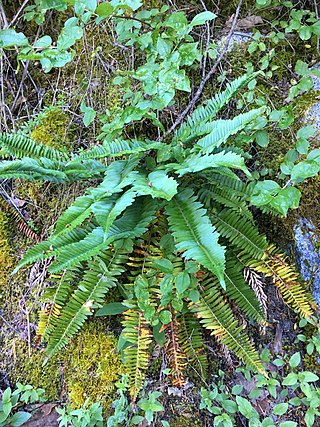
Polystichum imbricans is a species of fern known by the common names narrowleaf swordfern and imbricate sword fern. It is native to western North America from British Columbia and Idaho to southern California, where it grows in rocky soil and cracks in rock outcrops in coastal and inland mountain ranges and foothills.

Polystichum lemmonii is a species of fern known by the common names Lemmon's holly fern and Shasta fern. It is native to western North America from the Sierra Nevada of California north to Washington. It is also known from British Columbia, where there is a single occurrence in the mountains above the Okanagan Valley.

Polystichum lonchitis is a species of fern known by the common name northern hollyfern, or simply holly-fern. It is native to much of the Northern Hemisphere from Eurasia to Alaska to Greenland and south into mountainous central North America. It has stiff, glossy green, erect fronds and grows in moist, shady, rocky mountain habitats.

Polystichum scopulinum is a species of fern known by the common names mountain hollyfern and rock sword fern. It is native to much of western North America, and it is known from disjunct occurrences in eastern Canada as well. It grows in rocky habitat, often in full sun. It is widespread but mostly found in small populations, and is noted to be most abundant on serpentine soils. This fern produces several erect, narrowly lance-shaped leaves up to 50 centimeters in length. The leaves narrow near the bases. Each leaf is divided into many lance-shaped or oblong leaflets up to 3 centimeters long. The toothed leaflets are sometimes twisted on their axes and overlapping.

Physematium scopulinum, also called Woodsia scopulina, is a deciduous perennial fern in the family Woodsiaceae, with the common name Rocky Mountain Woodsia,.

Adiantum viridimontanum, commonly known as Green Mountain maidenhair fern, is a fern found only in outcrops of serpentine rock in New England and Eastern Canada. The leaf blade is cut into finger-like segments, themselves once-divided, which are borne on the outer side of a curved, dark, glossy rachis. These finger-like segments are not individual leaves, but parts of a single compound leaf. The "fingers" may be drooping or erect, depending on whether the individual fern grows in shade or sunlight. Spores are borne under false indusia at the edge of the subdivisions of the leaf, a characteristic unique to the genus Adiantum.

Myriopteris wrightii, formerly known as Cheilanthes wrightii, is a species of cheilanthoid fern with the common name Wright's lipfern. It is native to the southwestern United States and northern Mexico.



























